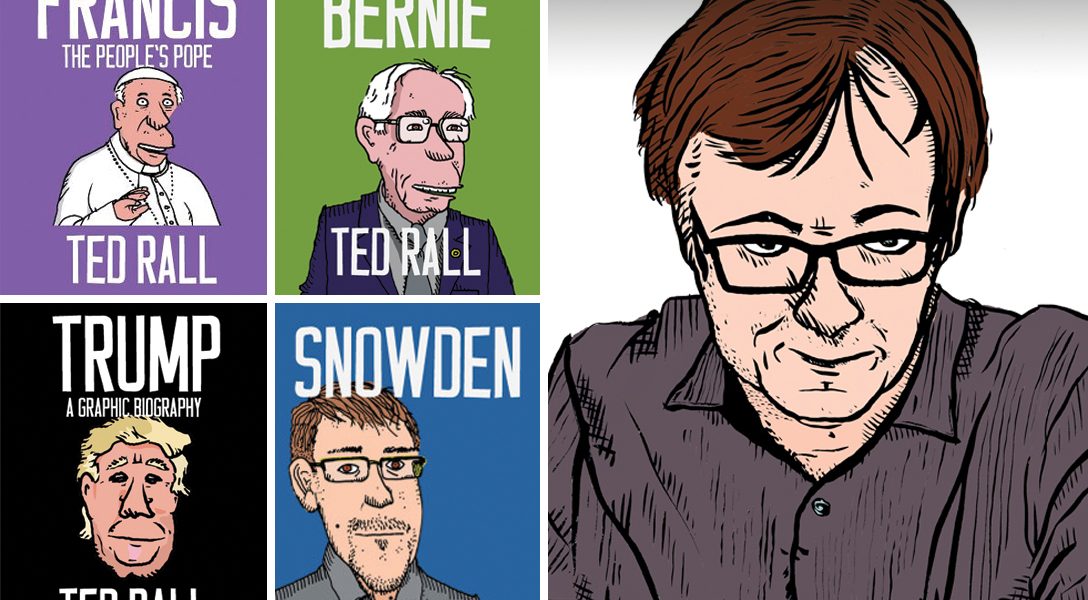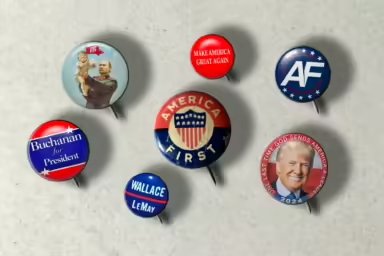Cartoonist Ted Rall talks about the state of journalism, the death of irony, and the effort to save the once-powerful political cartoon.
While some argue that we are living in a golden age for journalism, the decline of print outlets has certainly changed the economic landscape for the worse. The transition from print to digital was not an easy negotiation, losing both people and content in the process.
One of those casualties was the classic editorial cartoon. Once a bastion of irony that allowed us to look askance at the world and find humor in all things political, the current examples often feel banal and safe.
Among the few political cartoonists still upholding the tradition of no-fear-or-favor commentary in today’s straitened media landscape is Ted Rall, our guest on this week’s WhoWhatWhy podcast.
For over 25 years, Ted Rall, who recently joined the WhoWhatWhy editorial team, has used his drawing pen to take on everything from popes and presidents to endemic corruption and war.
With our own Jeff Schechtman, Rall talks about the joy of poking fun at all sides and the irony of his using the internet to reach a wider audience. Unfortunately, that expanded reach has not yet translated into sustainable funding for his brand of wickedly funny gadfly journalism.
Rall appreciates the career he had before the collapse of print and hopes that in this Instagram age, with the rise of forward-leaning sites like WhoWhatWhy, there still might be a future for the sophisticated and intelligent satire of the political cartoon.
Click HERE to Download Mp3
Full Text Transcript:
As a service to our readers, we provide transcripts with our podcasts. We try to ensure that these transcripts do not include errors. However, due to time constraints, we are not always able to proofread them as closely as we would like. Should you spot any errors, we’d be grateful if you would notify us.
| Jeff Schechtman: | Welcome to the WhoWhatWhy podcast. I’m your host, Jeff Schechtman.
The transition to internet journalism has changed many things. Certainly for the practitioners of journalism, job and pay cuts have been the most obvious form of that change. For readers, the interesting life beyond the stories has often been lost. Opinion columns, letters to the editor and editorial cartoons have all been truncated in today’s news context. We are all pressed for time. We’re consuming more from cable news and podcasts, and confirmation bias keeps us from exploring too far beyond our own limited scope of vision. My guest Ted Rall is trying to buck this trend. A long time political cartoonist, columnist, and occasional war correspondent and radio host, Ted is trying to keep alive a sophisticated and intelligent advocacy and engaged journalism that often runs counter to what technology is shaping in the new landscape. It is my pleasure to welcome Ted Rall to the WhoWhatWhy podcast. Ted, thanks so much for joining us. |
| Ted Rall: | Thank you so much for having me, Jeff. I really appreciate this opportunity. |
| Jeff Schechtman: | Talk a little bit about how you got into journalism, first of all. You were originally going to be a physicist, an engineer. How did you make that switch? |
| Ted Rall: | Well, actually originally I wanted to be a journalist, and it was a long and winding road to get there, and we don’t have hours, so I’ll give you the nut graph. But when I was a kid I worked on the school paper and I was lucky enough to get my cartoons in the local paper at the age of 15 and it’s really what I wanted to do. By the time I went off to college in New York, I had eight local newspapers, which just to put this into proper perspective, in this day and age, if you were a young cartoonist, if you were, hell, a 40 year old cartoonist, you would have a hard time finding eight local papers to pick up your editorial cartoons. But back then it was easy. Then I went off to college and I studied engineering because the school I was admitted to, Columbia, was the only one that gave me a scholarship. |
| Ted Rall: | So that’s what I studied, but I wasn’t good at it and it was too hard and I didn’t like it. So all that stuff was just, and I didn’t really care for my classmates who were, I thought, too careerist during the Reagan years, not political enough. So anyway, I managed to get myself expelled and when I did, I pretty much just struggled from one job to another. I was a banker, I drove a taxi, I was a computer programmer. To date this story, it was FORTRAN 77, and by the time I realized that really cartooning was my passion, it was the late 80’s. At that point, every day job I ever had after that was just a day job. I still worked in banking and I worked at the admissions department at Columbia, but all I wanted to do was draw cartoons. I got really serious and I broke through in the early 90’s when I got syndicated and pretty much after 1995 that’s been my full time occupation. |
| Jeff Schechtman: | Talk a little bit about becoming a political cartoonist and the combination of both the artistic side of it, the political side of it, how they came together for you, and a little bit about the arc of your own views as they’ve been reflected in your cartoons over all of these years. |
| Ted Rall: | I think I’m one of those kids who just kept being a kid. There’s a movie called Tag that’s currently on HBO that I highly recommend, and they talk about this Wall Street Journal article about these kids who decided to keep playing tag the rest of their lives, and they’re now in their 60’s and they still play tag. They just said, “In order to stay alive, to not grow old, you just never stop playing.” I was a kid who loved cartoons and, like a lot of kids, I drew them and I was inspired by the local cartoonist at the Dayton Daily News, Mike Peters, who’s still there, and I just kept doing it. It’s like a kid who always wanted to be an astronaut or a firefighter and just becomes one. So, for me, it was something I just never got rid of. I’ve always given a lot of stock to what makes a good cartoon and why people view them as so powerful to the point that some cartoonists have actually been killed, assassinated over them. |
| Ted Rall: | I think it’s the simplicity of the form. You do not need a college degree or a high school degree to draw a good political cartoon or be a successful cartoonist. In fact, people who go to art school and study this format very rarely become successful. People say, “What should you study?” I’d say, “Well, take art classes so you end up drawing better than I do.” But definitely have your own style and study history and politics, and that’s really the form. There’s just something about the way words interact with pictures that go back thousands of years. There’s cuneiform cartoons. There’s political cartoons on the walls at Pompeii and Herculaneum. It’s just a format that goes very, very well together. These days the internet has memes and what is a meme? A meme is an image plus words, right? A meme is a cartoon. It just uses a photograph instead of a drawing. So there’s no difference whatsoever. |
| Jeff Schechtman: | Talk about the satire aspect of it and the way that has become incorporated, both satire and irony. |
| Ted Rall: | Well, so there’s a lot of different tools in the cartoonist’s toolbox and so definitely one of the most powerful things you can do is to ridicule the people who are pompous, wealthy, powerful, influential, and reduce them to a series of simple line drawings that unveils their fundamental ridiculousness. But you can be silly, you can be profane, you can be furious, you can be sad, you can be maudlin, you can be cheesy. All of these things work for different types of cartoons and it’s a deceptively complicated form because, like I said earlier, anyone can draw one. James Thurber wasn’t much of an artist, but he was a great cartoonist. Gary Larson wasn’t much of an artist, but he’s a great cartoonist. So any kid can draw one and people look at them and they say, “Well why can’t I do that?” |
| Ted Rall: | It’s like, well, maybe you can, but it’s because it’s deceptively simple, you have to figure out which cartoon, which idea, which message requires the picture to come first, which requires the words to come first, and hopefully you don’t have anything extraneous. You just want as little as possible and sometimes a little is a lot. Sometimes you have to have a very wordy cartoon to make it work or you have to have a very complicated image. But what you’re trying to do, as my mom used to say, is make something very complicated, simple. Any idiot, she used to say, could make something simple, complicated, but being able to synthesize, that’s really the key to a good cartoon. Now, I think unfortunately there’s been a variety of trends in our profession that have been caused by budgetary pressures and censorship and self censorship. |
| Ted Rall: | One of the most unfortunate, I think, is the tendency to illustrate the news rather than to comment on it. In other words, when you see a cartoon where you can’t really tell if the cartoonist is a Democrat or a Republican, but they’re just saying like, look, this is happening. So for example, an obituary cartoon. This famous person died. It is sad when people die, but that’s not taking any kind of stand. Or there are recession jitters. People… the market is worried about possible recession. It’s not an editorial cartoon. It’s an editorial illustration. Nothing wrong with editorial illustration. They’re very good art forms. I’ve done it myself many times, but they’re not political cartoons. Political cartoons stakes out territory, takes a stand. Ideally it takes a stance that is novel in some way, whether it’s the stance itself is unusual or it forces you to think about an issue in a new way. |
| Jeff Schechtman: | In many ways it’s a form of artistic poetry I suppose. |
| Ted Rall: | Yeah. It’s funny, when I was in high school, we tried to have a band called Autistic Children, or sorry, Artistic Children and would not fly now, didn’t fly then. It is a little bit, and there are some cartoonists, I will not name names, but some of the more gifted ones in my profession who have this sort of idiot savant approach to cartooning. I actually don’t think I’m one of them, and I don’t mean that as a way to denigrate them. Something where, if you can just really connect with your id as a cartoonist and just let loose, that is a liberation that is going to tap into the anarchy. I forget the cartoonist who said this, but it might’ve been, actually, I think it was Gary Larson who did the Far Side, who did a book where he showed his rough sketches and he said that it was really hard to get back to, when you went to final art to draw, to get that looseness of the rough sketch. |
| Ted Rall: | With the rough sketch, you don’t care about the art. No one else is going to see it besides you and maybe an editor who you really trust. So you just draw it quickly, and then when you go to draw the final art, you’re aware of the fact that it’s going to be published and appear online, so you’re more conscious and you want it to be prettier and you’re trying to gussy it up with nice colors and make sure there’s no smears or anything. But what you’re ending up with is something that’s too polished in a way sometimes. |
| Ted Rall: | It’s like the difference between listening to an early Rolling Stone set, where it’s sloppy and very lively, and like The Stones after the 1980’s, where everything got highly produced and synthesized and 16 track overdubs. So it might sound good, it might sound slick, but it doesn’t sound alive. Cartoons are the same way, and I think those kinds of cartoonists who can be super loose like a, well actually Jeffrey Brown is like that. He’s not a political cartoonist, but he’s a great, great, great, great cartoonist and he draws the roughs straight into his books and that’s it. It doesn’t go to final and it’s awesome. |
| Jeff Schechtman: | One of the things that’s so remarkable is that you were talking about when you started back in the 90’s, there were so many cartoonists back in those days and how the form has just continued to evaporate. |
| Ted Rall: | Yeah, well, it hasn’t been evaporated. It’s been studiously murdered. When I got into this, there were many hundreds of editorial cartoonists. There was an annual book no longer published, which says a lot, called Best Editorial Cartoonists of the Year, like 1982 or whatever. That book had staff cartoonists work from papers that you’d never even heard of. A paper in Ashtabula, in Rome, Georgia. They had their own staff cartoonist drawing cartoons about state, local, and national politics, and international politics. So there were hundreds of us all over the country, and when the budget cuts hit over the decades, and this is not a new thing, it’s accelerated since, I’d say, since the late 1990’s but newspapers have started to see circulation drops starting in the early 60’s. Every time they’ve cut the budget, when the bean counters come along, they tend to think of the editorial cartoonist as disposable. |
| Ted Rall: | At first, it was not because they didn’t respect the form, but because it was way too tempting to replace a $100,000 a year editorial cartoonist with a syndicated package that would contain cartoons by Pulitzer Prize winning cartoonists like Pat Oliphant and Jeff Macnelly, and just like, well, for $15, I can run this same cartoon and I can fire my $2,000 a week cartoonist. It’s very hard for a budget stuck newspaper editor to say no to that. |
| Ted Rall: | But then the syndication model started to break down because all the staff cartoonists who were drawing the syndicated material were themselves losing their jobs. So the syndicated stuff was being subsidized by newspapers, those subsidies went away, and so people realized they just couldn’t make money drawing cartoons. So now we’re at a point where there’s fewer than 20 cartoonists in the US, and to put that into proper perspective, there’s more editorial cartoonists working at newspapers in Tehran than there are in the United States. There were more political cartoonists killed behind their desks at Charlie Hebdo in Paris than worked east of the Mississippi River in the United States at that time. So we’re really the last of the Mohicans. I’m almost 56 years old, and I’m considered one of the youngest. |
| Jeff Schechtman: | One of the things that also had a profound impact certainly in your life, and you’ve talked about this, is 9/11 and how that affected the business. |
| Ted Rall: | Well, 9/11 was crazy. Before 9/11 took place, I was in a lot of print magazines. I was in Time Magazine, Fortune magazine. I was in Silicon Alley Reporter, Bloomberg’s magazine, and a bunch of newspapers. Then I remember about three days after 9/11, I got a call from the art director at the time and he said, “Oh, we’re getting rid of all the cartoons. “We’re also getting rid of,” they had a satirical column, “We’re getting rid of all humor from the magazine because people are never going to want to have humor again.” I just started laughing at him because I thought it was the most absurd thing I’d ever heard. I thought it was so stupid, plainly stupid, that this would be a mentality that would be like, look, you’re going to pick yourself up next week and realize that you were on a [inaudible] and now it’s time to get serious and get back to work. But they didn’t. |
| Ted Rall: | That mentality spread throughout journalism, where satire was considered too dangerous, that the country had become so politicized, so militaristic, so jingoistic and patriotic following the attacks, that there was a desire to keep playing it safe, not just in the coverage in general, in the straight news, but also in the commentary. So you just saw the editorial pages drifting to the right. First the hard-hitting cartoons disappeared. I’d like to consider mine to be in that category, and then less hard-hitting ones, and ultimately, completely. Even under Obama, that trend did not really reverse. It just kept going, and we’re at a stage now where you look back and I’m like, it’s crazy. I remember the year between 2001 and, say, 2003, my income went down three quarters, and it never really came back and I got hurt less than most of my peers. It was absolutely devastating. |
| Ted Rall: | The syndication business, the associations affiliated with this business are just completely on the ropes or shattered, and it’s crazy because readers like them. They really do. But you have to convince editors of that and even after you do convince them, all it takes is one shaky publisher and you’re gone. I was the cartoon editor at Daily Beast, and at that time, we were making good money for Daily Beast. Cartoons get a lot of clicks. They share a lot on social media, they’re definitely revenue positive, even if you pay the cartoonist fairly well, but you have to convince editors. |
| Ted Rall: | So at Daily Beast, they realized that we were doing well and they moved us to a day of the week when they thought we would actually draw traffic to a slow day of the week, which was Saturday. Then we did poorly and then it was almost like they were looking for an excuse just to shiv us, and they did and we were gone. Same thing happened to two other places. You just need a model where you can … I’m convinced that if one website, like Salon or Slate, whatever, hires a cartoonist or runs a good roundup of cartoons and does well, then everyone else is going to want them too. But we’re just not there yet because they’re what we call in the business, they’re word people. |
| Jeff Schechtman: | Of course, your experience at the LA Times was another example of controversy and how editors responded to it. |
| Ted Rall: | Yeah, well, the LA Times, someone smarter than me observed that what happened to me was really a symptom of the decline of print media. What that was, was back in 2014, the parent company of the Times at the time, Tribune Publishing, based in Chicago, just decided that they were just so broke that they needed to bring in publishers who could midwife broke deals to buy company stock in order to shore up the stock price. So as part of this strategy, the LA Times hired a guy named Austin Beutner, who was a hedge fund billionaire, to come in and be the publisher. He midwifed this deal whereby the LAPD pension fund, and the LAPD was a close political ally of his, acquired a number one shareholder interest in Tribune, which owned 15 newspapers, including the LA Times. If you really think about it, why would a pension fund want to buy newspaper stock? |
| Ted Rall: | Well, I mean newspaper stocks have been declining. They’re a terrible investment. Tribune was one of the absolute worst performing stocks of all media companies in the United States at the time. They just wanted the political influence of being able to control an editorial page. So they never bothered to tell me, “Hey, we’re now owned by the LAPD, don’t do cartoons about the cops.”, and I think it happened at such a high level, that the word never trickled down to my editors. I have to say I’m not that brave. If they had told me don’t draw cartoons about the police, I would not have. No one told me, and eventually I did one too many cartoons about the cops, one about jaywalking, and it came with a blog that was about my own personal experience being arrested and roughed up by an LAPD officer 14 years previous in 2001. It’s not like a terribly controversial blog. |
| Ted Rall: | All I said was that I was roughed up and handcuffed to the point where an angry crowd of people gathered and yelled at the police officer and he gave me my ticket and then left. That’s not an unusual experience in LA. Lots of people are handcuffed for jaywalking there, the police are pretty brutal. But anyway, the LAPD gave the publisher, Austin Beutner, an audio tape that reportedly showed that I had lied, that the cop was really nice, that there was no angry crowd, that I was never handcuffed. But when you listened to it, you really couldn’t hear anything. It’s all just static and street noise. So they published a piece saying that there were massive discrepancies between my story, my account, and what the audio showed. Remember the audio just didn’t show anything, and then they said, “We’re not going to use Ted Rall anymore.” |
| Ted Rall: | So they didn’t, and I went to a company, a post production company in LA, and they had the audio cleaned up, they call it enhancement, audio enhancement. When they did it, they reveal that in fact you could hear the angry crowd yelling at the police officer. You could hear someone yelling at the police officer, “Take off his handcuffs.” So I sent this to my editors. At this point they just went completely non-responsive. They’d like, “I can’t hear you.” They never talked to me about it. They never wanted to discuss it. Clearly the fix was in, I was out less than 24 hours after they received this audio. But then three weeks later, they published a second piece because they were under so much pressure from social media, where they doubled down on their accusations, and this time they said they had hired, finally, their own audio experts that themselves couldn’t hear anything. |
| Ted Rall: | But then when we talked to one of the audio experts, in fact he hadn’t really been hired and the Times lied about that. He didn’t do a proper enhancement. So of course he couldn’t hear anything because he was never hired to do it. So we have that evidence and I have filed suit for wrongful termination and defamation, and that’s working its way through the California court system now. They’ve been fighting tooth and nail because they just don’t want this to go to trial. They don’t want discovery because obviously they know they were really wrong and it is a sign of what happened. Ultimately, Austin Beutner was pushed out for trying to engineer a boardroom coup. The police chief who gave him the audio was pushed out, forced early retirement in a series of scandals and Tribune finally sold the LA Times to a local businessman named Dr. Pat Soon-Shiong. But these legal things tend to be on autopilot. I seriously doubt he even really knows what’s going on with my case. |
| Jeff Schechtman: | Talk a little bit about the way cartooning, what’s left of it, and to the extent that it’s still going on and you’re still doing it, how it plays in the internet era, how it plays in digital format compared to the way it used to play in print. |
| Ted Rall: | Well, I think it’s incredibly similar to be honest. The only real difference is that digital media, particularly smart phones, make cartoons extremely portable. So instead of cutting one out and putting it up by your desk at work and maybe your colleagues can see it, with a push of a button, you can push it out on Twitter or whatever and it’s going to go all over the place and get a life of its own outside of the context of the initial publication. That’s a big deal. Cartoons are more portable than really anything else I can think of. They’re more portable than prose because even a relatively short piece, let’s say it’s 500 words, that’s still asking a lot when that thing pops up on your phone for someone to read it. A lot of people, in fact, there’s been stories about how most people who forward articles have not actually read the articles themselves. |
| Ted Rall: | They just look at the headline and forward it approvingly, but people will actually read the cartoon. So, I would say the only thing that I would like to see is a budget for doing animation, because animated political cartoons I think have a lot of potential. We’re now at the stage where you could turn around an animated cartoon in under a day after a story breaks. The problem is that it’s still expensive and you still need a budget for it. But I keep thinking that there may be potential there, I’d like to see someone explore it. |
| Ted Rall: | There’s only one cartoonist in the country who ever made it work, Mark Fiore based in San Francisco, and he won a Pulitzer for it. But it just seems to me that with such an emphasis on video in other formats, that cartoons that move might have potential too. I tried my hand at it in 2009, 2008 and I love them. They’re on my website. They’re very funny. But they were a lot of work and I never made a dime because I couldn’t sell them. |
| Jeff Schechtman: | The fact that there is so much visual content online and that we live in this Instagram era, has that helped? |
| Ted Rall: | I think it’s worse and better. On the one hand, well, we went through a phase where pretty much everything was considered the same, right? So for example, we were told we no longer need a media bureau in Kabul because you can hire local Afghans to take photos with their cell phones and serve as stringers on the scene when something happens there. |
| Ted Rall: | But obviously we have now started to understand the difference between a professional photographer and someone who takes a picture with their iPhone. No matter how lucky or talented they are, they’re just not the same. Professionalization, I think, is starting to come back. People are starting to understand the difference again. The fact is, anyone can make a meme but how many people can make a good one? Not very many. Then how many people can make a good meme every day? Very, very few. So that’s where professionalization in the field of cartooning or anything else really comes into play. I think everyone’s got one or two good stories to tell or to write or photograph or to draw. But someone who writes every single day, someone who thinks about the news and current events every single day, is just necessarily going to be better at their job in the same way that my mechanic, who fixes cars every single day, is better at fixing cars than I am when I do it once in a blue moon. |
| Jeff Schechtman: | Do you think that because there’s so much political coverage today and so much political focus, even though it has this powerful partisan nature and divisive nature today, that that ultimately will help or encourage or inspire more people to get in the cartooning business? |
| Ted Rall: | Well, at this stage I could not in good conscience encourage anyone to get into the cartooning business. There’s just no work. No matter how brilliant you are, the odds are you’re going to end up as a barista while you’re trying to draw cartoons, and that’s just not fair to anyone. But I do think that the polarization is a natural place for cartooning. If you think about where cartoons were appearing in the late stages of print journalism, in the 80’s and 90’s, on the op-ed pages of major newspapers, those were genteel places edited by genteel people, where the politics tended to be very centrist, ranging from center left to center right. There really was no space for a strident, hard-hitting, ass kicking voice like a good editorial cartoon is. The fact is a polite editorial cartoon, as Mike Lester, the editorial cartoonist said, he’s a conservative. He said, “It’s not a cartoon, it’s a greeting card.” |
| Ted Rall: | Now that things are more rough and tumble, where even the president is really way over the top, and the rhetoric on the left is more strident as well as on the right, no one looks at an editorial cartoon and thinks, Oh my God, those guys are crazy! W-T-F, what is with them and their obnoxious tone? You might not agree with the specific politics of that cartoon, but you’re not going to question the entire format, the entire genre, the way that people did 30 years ago. So I think, you know what I mean, an age of polarization, people bemoan it. I don’t. I think the only thing I don’t like about polarization is that people tend to just not hear opposing arguments, which is really stupid. I’m not wired that way, but apparently most people are, but in terms of the freedom that it gives you to be far left or far right or anywhere in between, I think that’s better for the country really. |
| Jeff Schechtman: | Maybe comedy and satire and irony, all those things that are part of a political cartoon, maybe those are one of the few things that people on the other side can hear or can get or will listen to. |
| Ted Rall: | Yeah. If you speak to them in a clever way instead of talking down to them, and that’s hard. The fact is, I looked back at some of my George W. Bush era cartoons and I think, Oh my God, these are so strident. It’s just, if you agree with George W. Bush, if you’re in favor of the Iraq war, you’re an idiot and you’re in favor of mass murder. I’m like, yeah, that’s not winning any hearts and minds. That’s not convincing anyone of anything. It might in another country, but the culture of this country is definitely much more Bob Newhart-ish, very calm, wry, droll and controlled. That’s the humor that works best is when you haven’t lost it. |
| Ted Rall: | Looking at someone like George Carlin or someone like that, just sort of bemusedly scorning another position or cleverly just dissecting it one bit at a time until the house of cards falls down. You know you’ve won when you get emails from conservatives, in my case, who are on the other side of the fence and say, “You know, you made me think about that. I never thought about that issue the same way before. Thank you for that.” That’s awesome. You’ve succeeded because anyone could preach to the choir, but when you can actually make people think, that’s huge. |
| Jeff Schechtman: | You’ve mentioned that there was a lot of older cartoonists and you’re one of the younger ones. Hopefully you’re not going to be the last one to turn out the lights. |
| Ted Rall: | No, and there are definitely some young ones coming up, but not very many. Very, very few really. We used to joke that we should be like World War One veterans, we should all buy a bottle of champagne together and whoever’s last gets to drink it and pour a little bit over our graves. It would probably be Matt Bors. He’s like 35. It’s sad. There’s no farm system anymore, and the farm system started to break down really when I started entering [inaudible 00:32:32]. I got syndicated in 1991. Everybody I’ve talked to says look, if I had started five years earlier, I probably would’ve worked on staff at a number of newspapers, but they just weren’t filling positions after that. You think about really successful cartoonists from the new generation, people like Tom Tomorrow, Ruben Bolling, Ward Sutton, none of them ever were offered a job on staff in a newspaper. That just wouldn’t have been the case five or 10 years earlier. |
| Jeff Schechtman: | Ted Rall, I thank you so much for spending time with us. |
| Ted Rall: | Thank you so much. I really appreciate it. |
| Jeff Schechtman: | Thank you. Thank you for listening and for joining us here on Radio WhoWhatWhy. I hope you join us next week for another Radio WhoWhatWhy podcast. I’m Jeff Schechtman. If you liked this podcast, please feel free to share and help others find it by rating and reviewing it on iTunes. You can also support this podcast and all the work we do by going to whowhatwhy.org/donate. |
Related front page panorama photo credit: Adapted by WhoWhatWhy from Revolution Books / Vimeo (CC BY 3.0).






